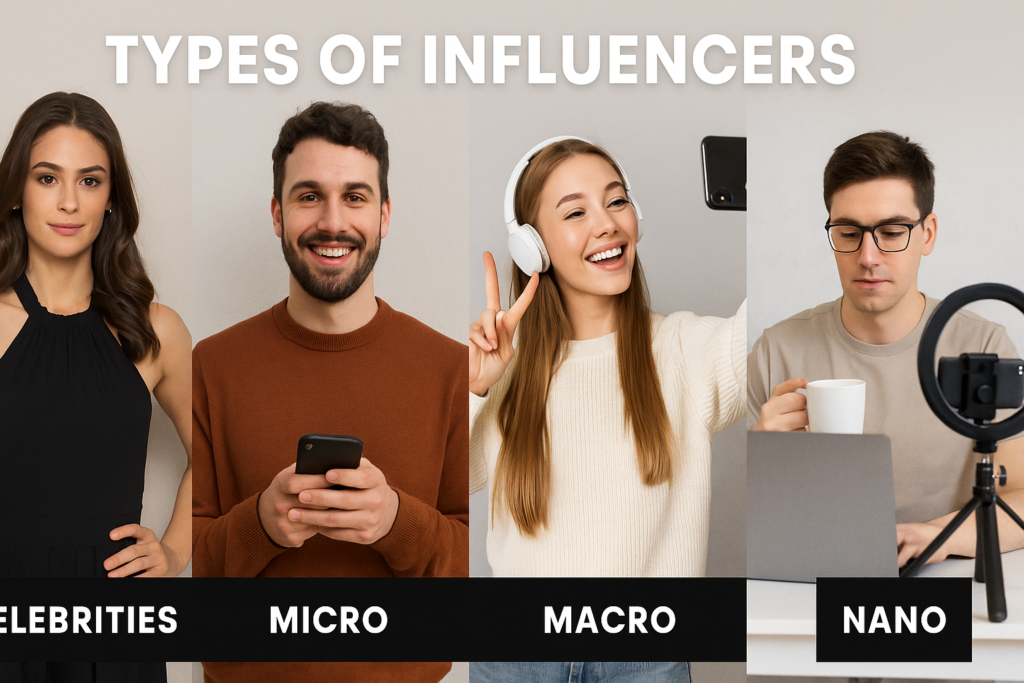In the domain of current marketing, influencers have become vital figures for brands looking to associate with assorted audiences. From social media experts to industry experts, influencers employ the ability to shape customer conclusions and drive commitment.
Table of Contents
ToggleIn this article, we’ll explore different types of influencers, each with its novel attributes, reach, with effect and how influencer marketing services in Thane can help to reach them.

Types of Influencer
1. Celebrity Influencers:
Maybe the most customary form of influencer, celebrities influence their popularity and status to embrace products or services. With monstrous followings on social media platforms, celebrities can enhance a brand’s message to a global audience in a split second. While their compass is broad, joint efforts with celebrity influencers often accompany a powerful sticker price.
2. Macro-influencers:
In terms of follower count, macro-influencers are just below celebrities. They commonly have a significant online presence and a solid following in a specific speciality. With follower numbers ranging from thousands to millions, they balance expansive reach and a more drawn-in speciality audience. Macro-influencers often collaborate with brands across different businesses.
3. Micro-Influencers:
Micro-influencers have a more modest yet exceptionally connected following, commonly going from two or three thousand to around 100,000 followers. What they need is a huge reach, which they compensate for in authenticity and an affectionate relationship with their audience. Micro-influencers are often seen as more engaging, making them compelling for speciality marketing campaigns and localised brand promotion.
4. Nano-Influencers:
Nano-influencers are people with a more modest yet profoundly drawn following, often in the range of 1,000 to 10,000 followers. Their solidarity lies in the profound, unique interactions they have with their audience. Nano-influencers are often viewed as friends or peers, causing their proposals to feel genuine and reliable. This kind of influencer is especially successful for hyper-local or speciality marketing efforts.
5. Industry Experts and Thought Leaders:
Past social media characters and influencers can likewise be people perceived as experts or thought leaders in specific businesses. These influencers might not have gigantic follower counts, yet they convey critical impact within their professional communities. Collaborating with industry experts adds authenticity and believability to a brand’s message.
6. Brand Ambassadors:
Brand ambassadors are long-haul accomplices who adjust intimately to a brand’s qualities and vision. Not at all like oddball coordinated efforts, brand ambassadors keep a continuous relationship with the brand, often creating a feeling of progression and trust among their followers. This sort of influencer marketing centres around building a supported, authentic association rather than one-time promotions.
7. Employee Advocates:
Organisations are progressively perceiving the impact of their employees in moulding brand perception. Employee advocates, otherwise called internal influencers, share their experiences and bits of knowledge about the company culture, products, and services. Utilising employees as influencers can improve brand authenticity and encourage a feeling of community both inside and remotely.
8. Creative Influencers:
Some influencers are esteemed for their span as well as for their creative gifts. This incorporates photographers, artists, and content creators who team up with brands to deliver outwardly dazzling and engaging content. Creative influencers carry a novel viewpoint to brand joint efforts, making their content stand out in a packed digital space.
Conclusion
In the broad landscape of influencer marketing, the variety of influencer types permits brands to fit their systems to explicit objectives and interest groups. From macro-celebrities to micro-speciality influencers, every class offers its assets that might be of some value. Fruitful influencer marketing campaigns depend on an exhaustive understanding of these influencer types and thoughtful choices in light of the brand’s goals, values, and the ideal reach of their main interest group.


